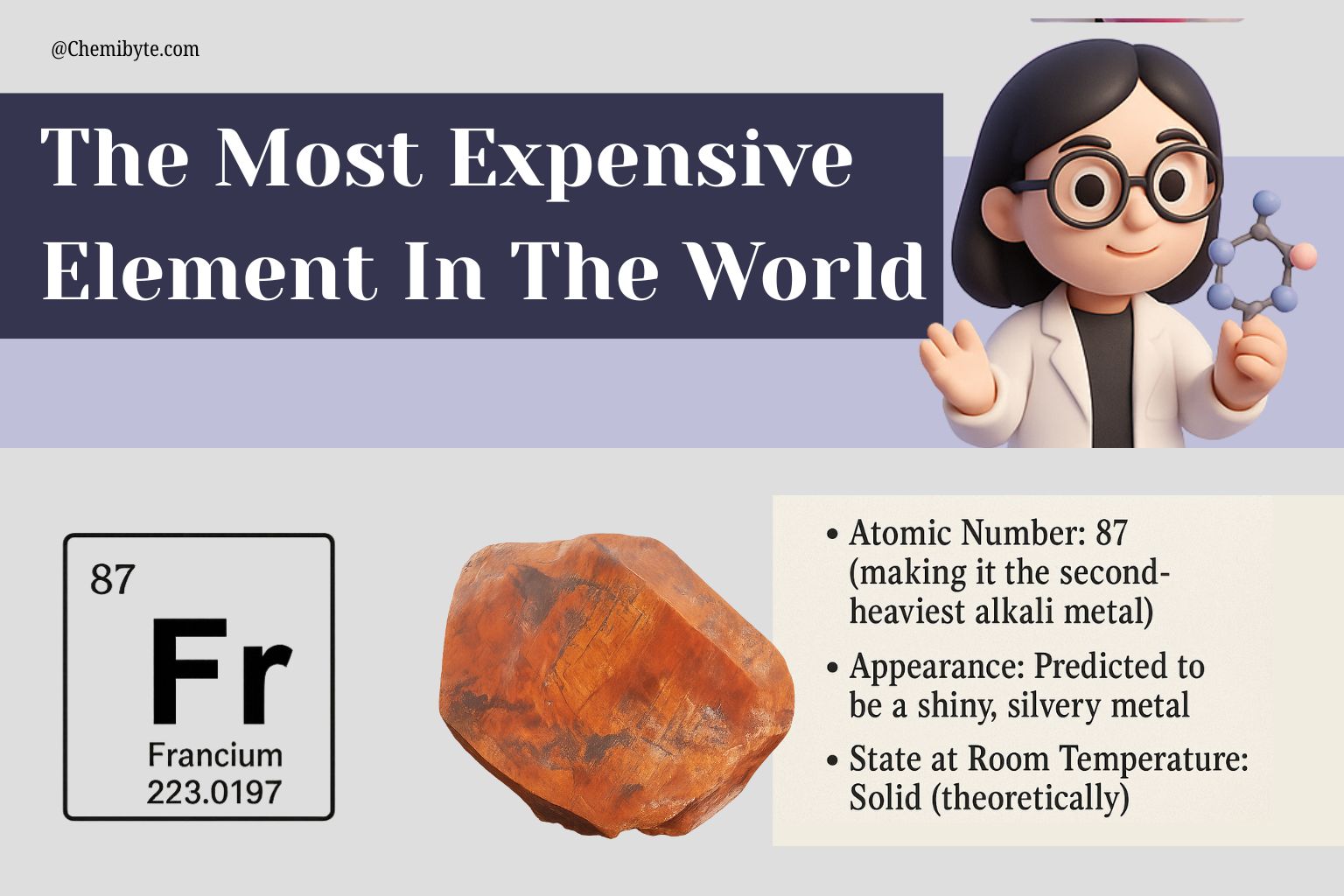The Million-Dollar Mystery: Inside the World’s Most Expensive Element – Francium
Imagine this: You’re holding something so rare, so valuable, that just one gram of it would cost you around 30 billion dollars. That’s not a typo. It’s more than the price of gold, diamonds, or even plutonium combined. You could buy luxury yachts, skyscrapers, or even fund a small country for a year with that kind of money.
So what is this mind-blowingly expensive substance?
Meet francium – the rarest, most elusive element on the periodic table, and officially the most expensive substance on Earth.
The Price Tag That’s Hard to Believe
Francium is valued at a jaw-dropping $30 billion per gram. Just think about that one tiny gram costing more than entire cities. But before you go dreaming about investing in francium and retiring early, there’s one big problem…
And trust me, it’s not just the price.
Why Is Francium So Expensive?
It’s not because the world is fighting over it. It’s not used in fancy gadgets or luxury products. And no, it’s not hard to manufacture in a lab. The reason is much simpler — and more extreme:
It’s Almost Too Rare to Exist
This element is so scarce, it might as well be a myth. The most stable version of it, Francium-223, is found in such tiny amounts that scientists estimate there are only 20 to 30 grams of it on Earth — at any given time. That’s barely enough to fill a teaspoon. And that tiny amount? It’s not sitting in a jar somewhere. It’s scattered across the planet, locked away in rocks deep underground.
You Can’t Store It – Even If You Tried
Even if you managed to get your hands on this element, you couldn’t hold onto it. Why? Because it vanishes almost instantly. Francium-223 has a half-life of just 22 minutes, which means in less than half an hour, half of it decays into something else. You can’t stockpile it, you can’t ship it, and you definitely can’t sell it. By the time anyone tries to measure it, it’s already fading away.
Mining Francium? Forget It.
Unlike gold or uranium, you can’t just dig up francium from the earth. It forms only as a byproduct of radioactive decay – mostly from elements like actinium and thorium. That makes natural francium basically inaccessible. And while it can be created in a lab using high-energy nuclear reactions, the process is so expensive, so delicate, and yields so little, that commercial production isn’t even considered.
The Elusive Properties of Francium
Despite its extreme rarity, scientists have managed to study it’s fascinating properties:
Physical Characteristics

– Atomic Number: 87 (making it the second-heaviest alkali metal)
– Appearance: Predicted to be a shiny, silvery metal
– State at Room Temperature: Solid (theoretically)
– Melting Point: Approximately 27°C (80°F) – it would be liquid on a warm day!
Chemical Behavior

As an alkali metal, this element shares properties with elements like sodium and potassium:
– Extremely reactive with water and air
– Would likely explode upon contact with moisture
– Highly radioactive and unstable
– Loses its outer electron very easily, making it highly electropositive
The Discovery Story

A Brilliant Discovery – Almost by Accident
This element was discovered back in 1939 by a remarkable French physicist named Marguerite Perey, who was working at the Curie Institute in Paris.
She wasn’t even looking for a new element. She was studying actinium and trying to understand how it decayed.
But while analyzing its radioactive behavior, she noticed something strange… a new kind of decay that didn’t fit the known patterns.
That “something strange” turned out to be francium – the final naturally occurring element ever discovered.
A Tribute to Her Homeland
In honor of her country, Perey named the element “francium.” To this day, it remains the only element named after France, and Perey’s work secured her a lasting place in scientific history. Her discovery wasn’t just a lucky break — it was the result of sharp intuition, rigorous testing, and a deep understanding of nuclear chemistry.
Why Francium Is So Expensive but Useless

There’s something almost poetic – even ironic about francium’s worth.
On paper, it’s the most expensive substance on Earth, far more valuable than all the gold ever mined. But in reality? It’s practically useless.
You can’t wear it. You can’t build with it. You can’t trade it or invest in it.
Try to make jewelry out of this element, and it’ll vanish before you’ve even finished admiring it. Use it in electronics? Not a chance, it’s far too radioactive and rare to be practical. It’s a fortune that literally fades away.
You Can Only See Francium for a Second
It’s kind of funny when you think about it.
it is is the most expensive element in the world, but you can’t actually use it for anything.
You can’t make jewelry from it – it would disappear in just 22 minutes.
You can’t use it in phones or computers – it’s too rare and radioactive.
And no, you can’t spend it like money either.
So why is it so valuable?
Valuable Because It’s Almost Impossible
This element is special because it’s so rare and so hard to see or study.
You can’t keep it in a bottle or collect it like gold. It’s too unstable, and it breaks down too quickly.
But for scientists, just being able to see francium for a few seconds is amazing.
It’s like finding a shooting star – gone in a flash, but unforgettable.
It is worth so much not because of what it does,
but because of what it is: a rare, mysterious, and short-lived wonder of nature.
– If you could somehow collect all the francium in Earth’s crust, it would fit in a small coffee cup
– It was initially called “actinium K” before being renamed
– It’s so reactive that it would probably explode if exposed to air
– Only about 30 grams of this element exist on Earth at any given time
– The element glows in the dark due to its intense radioactivity
– This element is more expensive than antimatter by weight (though antimatter is much harder to obtain!)
Will Francium Ever Be Useful?
Right now, francium has no real-world uses, not in medicine, not in industry, and not in technology. But that doesn’t mean it’s useless to science.
Because it is so rare and unstable, it’s very hard to study. But scientists are still interested in it because it can help us understand atomic structure better, especially how heavy atoms behave.
What Modern Research Says
Even though francium breaks down in just 22 minutes, scientists have found ways to trap small amounts of it using special machines like magneto-optical traps (MOTs). These traps slow down the atoms with lasers so researchers can look at them more closely, even for a few seconds.
Here’s what researchers are exploring with francium today:
-
Testing atomic theories: this element helps scientists check the rules of quantum physics by comparing it with similar elements like cesium and rubidium.
-
Studying weak nuclear forces: It can reveal more about the weak force inside atoms – one of the four main forces in the universe.
-
Exploring electron behavior: Studying how electrons move in such a heavy atom helps improve our understanding of atomic energy levels.
What About Future Uses?
For now, francium is too unstable to be used in any products or treatments. It’s not safe or cost-effective to work with in large amounts. But it still plays a small role in advanced physics research — especially in understanding how atoms behave at their limits.
So, will francium ever be useful? Maybe not in the way gold or uranium is, but it already helps scientists learn about the universe — and that kind of knowledge is valuable too.
Glossary
| Term | Definition |
|---|---|
| Francium | The rarest natural element on Earth, with atomic number 87. |
| Half-life | The time it takes for half of a radioactive substance to decay. |
| Actinium | A radioactive element that decays into francium. |
| Alkali Metal | A group of highly reactive metals in Group 1 of the periodic table. |
Read more interesting blogs from our web site:




Is it an alkali? Does it react the same way as other alkali react with water?
Yes, francium is an alkali metal. It would react with water like the others, but much more violently, it’s rare to see it directly because it’s too rare and radioactive.